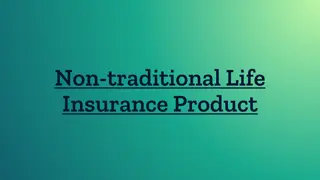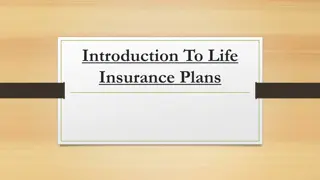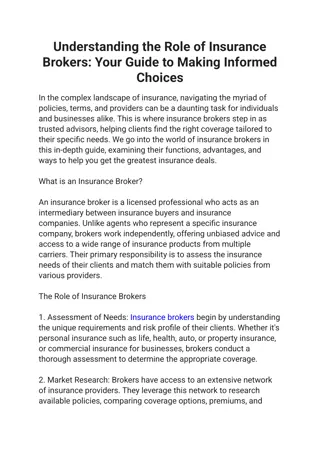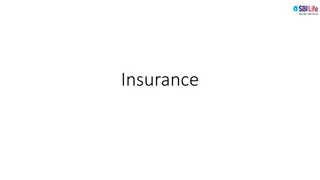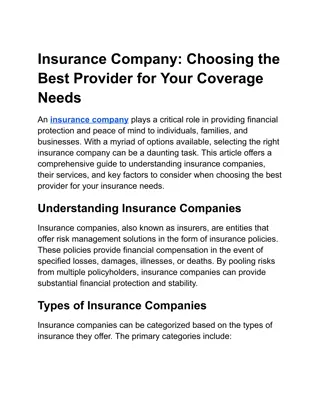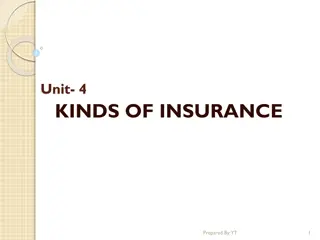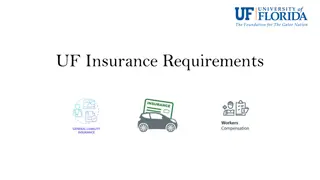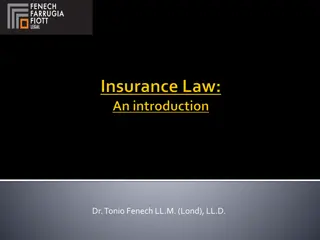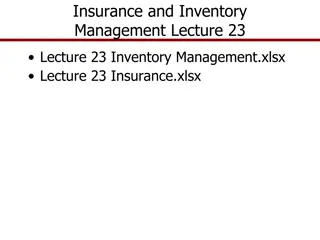
Life Insurance: Essential Considerations and Types Explained
Discover the importance of life insurance and how it can benefit your loved ones. Learn about key decisions like policy ownership, beneficiaries, and types of coverage. Explore term life insurance and its variations to make informed choices for your financial security.
Download Presentation

Please find below an Image/Link to download the presentation.
The content on the website is provided AS IS for your information and personal use only. It may not be sold, licensed, or shared on other websites without obtaining consent from the author. If you encounter any issues during the download, it is possible that the publisher has removed the file from their server.
You are allowed to download the files provided on this website for personal or commercial use, subject to the condition that they are used lawfully. All files are the property of their respective owners.
The content on the website is provided AS IS for your information and personal use only. It may not be sold, licensed, or shared on other websites without obtaining consent from the author.
E N D
Presentation Transcript
20 Farmers, each crop worth $100,000 * On average, 2 farmers a year lose their crops to bad weather, pests, etc.
Life Insurance In its most basic form, life insurance is simply a way to provide money to others following your death. Reasons include Replace income you would have earned for your family after you are gone Take care of debts that your family could be left with Pay for a child s education Business succession Provide liquidity to an illiquid estate or Pay estate taxes your heirs might face
You will need to decide: Owner of the Policy: Most often, the person being insured owns the policy. However, this is not optimal. Having a spouse or trust own the policy allows for greater tax efficiency. Beneficiaryof the payout: It can be one or more individuals, a charity, a Trust, etc. The owner should be as specific as possible in naming beneficiaries in order to avoid conflicts after death. You should name one or more contingent beneficiaries, in case the primary beneficiary predeceases the insured Type of Policy: a term life insurance policy, a permanent life insurance policy, or a combination. Amount of Benefit: How much do you want the beneficiaries to receive. Often based on Human Capital (PV of lost income) Delaware Insurance Commissioner
Human Capital vs Financial Capital Human Capital Financial Capital 120 100 80 60 40 20 0 25 30 35 40 45 50 55 60 65 70 Age
Term life insurance covers you for a specific period of time generally one to 30 years and pays a death benefit only if you die in that term. Because of its limited nature, the premiums for term insurance are smaller than other types of life insurance. You can renew most term insurance policies for one or more years, even if your health has changed. However, each time you renew the policy for a new term, premiums will likely be higher. 1 5 10 15 20 25 30 Years
Types of term life insurance include: Renewable. Allows you to renew your policy at the end of the term without submitting medical information. Your premium may go up after you renew, however. Level. Fixed premium & death benefit for the term of the policy Decreasing. The premium & death benefit decreases over the policy term $800 $700 $600 $500 Ex: $500k 20-yr policy, age 35 $400 Level $300 Decreasing $200 $100 $0 Year 1 Year 2 Year 3 Year 4 Year 5 Year 6 Year 7 Year 8 Year 9 Year 10
Permanent life insurance lasts your lifetime. Also known as cash value insurance or whole insurance Permanent policies often include a cash savings element. Because of the cash element and the fact that it lasts a lifetime, premiums are higher than term insurance. With a permanent policy, you lock in the premiums when you purchase it they will not change as you get older or as your health changes. http://tbn1.google.com/images?q=tbn:6nXNtgLuT-1rwM:http://www.adamtobinlaw.com/blog/wp-content/uploads/2009/06/saving-nest-egg.jpg
Whole.The most common type. Offers a death benefit with a cash value portion. The death benefit remains unchanged over the policy and the savings account grows based on dividends from the insurance company. Some whole policies let you pay premiums for a shorter period, such as 20 years, or until age 65. But premiums will be higher since the payments are made over a shorter time. Universal or adjustable. With this type, you may be able to increase the death benefit well after you have purchased the policy if you pass a medical exam. The cash value portion of this policy earns interest. Variable. Offers a death benefit and a cash value portion that is invested in stocks, bonds and mutual funds. Your policy may grow quickly if the investments do well, but both the cash value and the death benefit may decrease if the investments do not perform well. Some variable life policies have a minimum level below which the death benefit will not decrease. Variable-universal. Combines the investment aspect of a variable policy with the ability to adjust premiums and death benefit of a universal policy.
How to price life insurance? You use historic probabilities of death at various ages. http://www.ssa.gov/oact/STATS/table4c6.html What must be the probability of death for someone that buys a 20 year Term Policy that pays a $1M benefit at death and costs $500 per year? Total Premium Paid To Insurance Company = 20 x $500 = $10,000 $10,000 / $1,000,000 = 1% probability of dying within the next 20 years SO .. the price of insurance is simply = the Payout x the probability of the event occurring Note: we are ignoring the time value of money
Life Insurance Pricing: The price of insurance = the PV of the Payout x the probability of the event occurring An example. A 30 year old woman wants a 5 year $500,000 Term Life Insurance Policy Mortality Table from 2010 for Female Current Age 29 30 31 32 33 34 35 Survivors out of 100,000 98,668 98,608 98,545 98,479 98,408 98,332 98,252 Probability of Death 0.061% 0.064% 0.067% 0.072% 0.077% 0.081%
5 year $500,000 Term Life Insurance Policy Conditional Probability of Death x $1M $500k / Discount Rate (6%) = PV of Expected Payout Year 1 2 3 4 5 0.061% 0.064% 0.067% 0.072% 0.077% $304.05 $319.45 $334.87 $360.48 $386.15 1.060 1.124 1.191 1.262 1.338 $286.84 $284.31 $281.17 $285.54 $288.55 $1,426.40 The individual could : 1 Pay a lump sum of $1,426.40 on Day 1 or 2 Pay $338 each year for 5 years. Use a financial calculator to determine PAYMENTS that are equivalent to the PRESENT VALUE of $1,426
Annuities Insurance companies provide tax deferred growth of investments through annuities. Individuals contribute money all at once or over a number of years. Accumulation Phase At some point, the individual has 2 choices: 1. Begin taking withdrawals similar to a checking account. As you withdrawal, you lower the total balance. At some point you may deplete the account. Each withdrawal is taxable as ordinary income however a portion of the payment is return of principal. 2. Annuitize or Annuitization Phase . The investor makes an irrevocable transaction and trades their savings for a monthly (or quarterly, annual) income payment which will last as long as they live. The investor transfers the risk of outliving their savings. Mortality Risk = If the investor lives a long healthy life, they will be better off with an annuity. However, if the investor pass away before reaching normal life expectancy, they would have been better off NOT annuitizing.
Investment Risk = Investors can chose a fixed annuity or variable annuity. With variable annuities the future payouts will change. In bull markets variable annuities will see increases in monthly payments. And in bear markets, variable annuities will see decreases in income payments. A 60 year old man gives the insurance company $1,400,000 in exchange for one of the following: Type of Fixed Annuity Monthly Income Single Life, No guarantee $8420 Single Life, 10 Year guarantee $8240 Single Life, 20 Year guarantee $7690 2-Life, 2/3 benefit to Survivor, No guarantee $7990 2-Life, 2/3 benefit to Survivor, 10 yr guarantee $7980 2-Life, 2/3 benefit to Survivor, 20 yr guarantee $7900
Insurance is a device used to reduce risk by having a large pool of similar individuals share in the financial loss suffered by members of the pool Insurable Interest Adverse Selection Risk can be: Avoided Retained Shared Transferred
Various types of insurance policies are available However, they share common characteristics: Premium: the recurring charge to have an insurance policy in place Deductible: the amount of expenses that must be paid out of pocket before an insurer will cover any expenses CoPay or Coinsurance: the amount of expenses, beyond the deductible, which are shared between the individual and the insurer All policies can be adjusted to individuals preferences: Picking high deductibles and high coinsurance levels = Low premiums Picking low deductibles and low coinsurance levels = High premiums
Home Owners Insurance Homeowners insurance protects both your home and your personal possessions. It also provides liability coverage should someone be injured on your property. The main types of homeowners insurance are: Broad (HO-2) provides coverage for losses to your house and its contents from 17 perils, including fire and lightning, smoke, windstorms and hail, explosion, riot, damage from vehicles or aircraft, theft or vandalism, broken windows and other building glass, the weight of snow, sleet or ice, building collapse, falling objects, electricity surges or shorts (though TV and radios aren t included), as well as problems from accidents with your plumbing, heating, air conditioning, and appliances, including frozen pipes. Lower cost insurance!
Special (HO-3) is the most commonly used type of homeowners policy and covers losses from everything listed in HO-2 PLUS just about anything else you can imagine. Specific exclusions usually include intentional damage, floods, earthquakes, wear and tear, insect or rodent damage, nuclear accidents and war. There are also policies designed for: renters (HO-4), comprehensive coverage for your home and possessions (HO-5), condominiums (HO-6) Other types of policies variously called endorsements, floaters or riders extend protection to specific items you own.
Whats Covered Structures. Damage or destruction of your house, garage, shed and other structures are covered under the typical policy. Personal Property. The typical homeowners policy extends its protection to your possessions, including your furniture, appliances, electronics, clothes, jewelry, sports equipment and lawn tools. Most policies cover personal property at 50 percent of the policy limit. So if you have $100,000 worth of insurance on your home, you would have $50,000 (50% of $100,000) worth of coverage for your belongings. You should value your belongings and purchase additional insurance if needed Floods. Flood insurance is never included in a standard homeowners policy. Most flood insurance is offered by the federal government.
Valuable personal items. There will be a limit on how much you can be reimbursed for certain kinds of items. Policies vary, but typical limits include: $200 on money and coins $1,000 on stamps, tickets, securities (such as stocks) $1,000 for loss by theft of jewelry $1,000 on trailers $2,000 for loss of theft of firearms $2,500 for loss by theft of silverware $5,000 for computer equipment If you have something that is worth more than these limits, you should insure the item separately with an addition to your policy called an endorsement floater rider
Liability Insurance. Besides insuring your property, the typical homeowners policy includes coverage for injuries or loss to other people. If someone trips on your steps or sidewalk, it will cover that person s medical bills and other losses. It also may pay for injuries in accidents (not auto accidents) caused by you or a family member away from home, such as if you run into someone with your bike. Umbrella Policy: You can buy larger amounts of liability coverage at a relatively small cost. For example, $1M Umbrella Policy may cost $200/year
Disability Insurance Disability insurance is designed to replace a portion of your income in the event a sickness or accident prevents you from earning an income in your occupation. What it really does is protect families in the event one of the family members can no longer support the family because of an illness or accident. There are two threats to your ability to earn an income - death and disability. Disability isn't a certainty but what are the chances that you will be disabled or deceased before age 65? Age 25 30 35 40 45 50 55 60 Death 24.1% 23.5% 22.8% 21.8% 20.4% 18.3% 14.9% 9.3% Disability 34.8% 33.1% 31.3% 29.1% 26.3% 22.6% 17.6% 10.6%
A typical group plan offered by an employer will replace up to 60% of your salary. Supplemental plans and individual policies will often cover up to 70% or 80%. (No plan will cover all of your salary) Benefits typically last for a set number of years (say five years) or until you reach retirement age. If you pay the premium out-of-pocket meaning your employer doesn't cover the tab benefits are tax free. Elimination Period This is the period of time from the date of injury to the date the insurance company begins payments. policy to begin payments. A 30-day elimination period means that you have to wait 30 days for the
Short-Term vs. Long-Term Most Short-term disability insurance kicks in as soon as you're unable to work. Most employers provide some type of coverage, ranging from just a few days to as much as one year. Long-term disability insurance kicks in after the Elimination Period . You determine the Elimination Period when you initially purchase the insurance. Be sure to match the end date of ST Disability with the Elimination Period of the LT For example: If you have a 60 day ST Policy, purchase a LT Policy that has a 60 day Elimination Period 60 days 1Yr 5Yrs ST Coverage LT Coverage
Most people can't afford to live on just 60% of their salary. Purchasing an individual plan will allow you to insure another 10% to 20% of your income. Own Occupation This type of disability insurance pays benefits if you are unable to perform your own occupation even if you are able to do some other kind of work. Any Occupation - This type of disability insurance pays benefits if you are unable to perform any occupation Own occupation disability insurance will cost more. If you are a line cook at McDonalds earning $7/hr, you would purchase Any Occupation . If you earn $200k/yr as a software engineer you would purchase Own Occupation .
Private Health Insurance Health insurance can be purchased independently, or if you are fortunate enough, it may be partially subsidized through your employer. In either case, the options are the same. Policies have: Monthly premiums: paid by the individual, a company, or split between the two. Deductible: first dollar amounts paid by the individual before coverage begins. Co-payments: paid by the individual. May or may not apply to the deductible. Co-insurance: the individual may owe a percentage of the bill in excess of the deductible
Example: coinsurance clause. She becomes ill and is admitted to the hospital for several days. When she is discharged, she receives a hospital bill for $7,500 and a doctor bill for $3,250. How much will Ann s insurance company pay? Ann Jackson has a medical insurance policy with a $500 deductible and a 80% Loss Deductible Covered Loss Less 20% Insurance Company pays $10,750 ($500) $10,250 ($2,050) $8,200 Ann pays $2,550
Health Maintenance Organization (HMO) An HMO provides a broad range of services to its group of members for a fixed payment (usually very low in comparison). They provide both the financing of health care and the delivery of the health care. An HMO is comprised of contracted physicians and medical facilities with pre-negotiated contracts. It is as if the health care providers are employees of an HMO. Individuals must use physicians that are within the network. If a specialist is needed, the individual must first go to the physician and get a referral. Preferred Provider (PPO) A PPO is similar to an HMO except that it allows its members to use external health care services at a higher cost. PPO s are less restrictive. PPO s contract directly with health care providers for a reduced price in exchange for timely payment of fee s and increased volume. Individuals can go to a contracted health care provider or not. The cost depends on the option you chose and referrals are not needed.
Health Savings Account (HSA) A Health Savings Account (HSA) is a special account owned by an individual used to pay for current and future medical expenses. HSAs are used in conjunction with a High Deductible Health Plan (HDHP). Who is Eligible? Any individual that: Is covered by a High Deductible Health Plan (HDHP). Is not enrolled in Medicare Can t be claimed as a dependent on someone else s tax return Dependent children cannot establish their own HSAs
What Is a High Deductible Health Plan (HDHP)? Health insurance plan with a minimum deductible of: $1,350 (self-only coverage) $2,700 (family coverage) Annual out-of-pocket (including deductibles and co-pays) cannot exceed : $6,750 (self-only coverage) $13,500 (family coverage) These are 2019 established amounts and change annually for inflation
Contributions to HSA can be made by an employer or an individual, or both If made by the employer, it is not taxable to the employee If made by the individual, it is an above-the-line tax deduction!!!! Individuals can make a one-time transfer from their IRA to an HSA, subject to the contribution limits applicable for the year of the transfer For 2019, the maximum amount that can be contributed (and deducted) to an HSA from all sources is: $3,500 (self-only coverage) $7,000 (family coverage)
Distributions are tax-freeif taken for qualified medical expenses. includes over-the-counter drugs No use it or lose it rules like Flexible Spending Arrangements (FSAs). All amounts in the HSA are fully owned by the individual Encourages account holders to be frugal with medical expenses Encourages account holders to shop around for the best value The HSA is owned by the individual, NOT their employer (Transferrable) Accounts can grow through investment earnings, just like an IRA. Same investment options as IRAs


